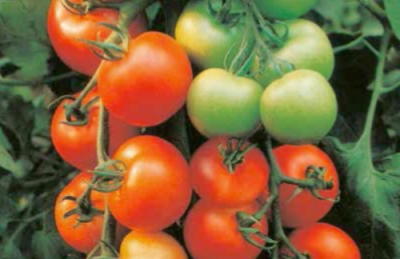
- Authors: Verschave Philippe
- Year of approval: 2008
- Category: hybrid
- Growth type: indeterminate
- Appointment: universal
- Ripening period: mid-early
- Growing conditions: for open ground
- Bush height, cm: 150-200
- Leaves: medium, dark green
- Unripe fruit color: green
Alesi tomatoes are an overseas hybrid that has found recognition not only in his native France, but also conquers vegetable growers and tomato lovers in other countries.
Breeding history
A fairly young hybrid tomato variety Alesi was approved for use in 2008. It was bred by the breeders of the French company Vilmorin. Initially, it was intended for cultivation in France, but it has taken root well in other countries.
Description of the variety
The variety is intended for cultivation both in the open field and in greenhouses. It has a universal purpose.
The height of the bush reaches 2 m. The plant has unlimited growth (indeterminate). Medium thick, dark green leaves.
The main qualities of the fruit
Alesi tomatoes are of medium size, their weight ranges from 150 to 170 g. The shape of the fruit is flat-round with a slight ribbing.
As it ripens, the fruit takes on a color ranging from unripe green to ripe red. There is no green spot near the stalk.
The pulp of the tomato is fleshy and dense. On the cut, it is deep pink, evenly brightly colored, without light spots. The skin is glossy, firm, but not hard.
Taste characteristics
The pulp of a tomato is distinguished by its fleshy, tender juiciness. It is not watery and has elevated sugar and lycopene levels. The taste is very pleasant, sweet and sour.
Ripening and fruiting
Alesi tomatoes are medium early. Full ripening takes place within 95-105 days from the moment the first shoots appear.
On one brush, tomatoes ripen at the same time.
Fruit ripeness when grown in the open field begins by August. In greenhouse conditions, the crop is harvested from June to October.
Yield
The yield of the Alesi variety is from 7.5 to 9.5 kg per square meter. 6-8 tomatoes are tied on each brush. Up to 8 kg of fruit can be harvested from one seedling. When grown in a greenhouse, 2 crops can be harvested in one season.
The timing of planting seedlings and planting in the ground
For the purpose of growing in greenhouse conditions, sowing for seedlings is carried out from January to March, and for open ground - from March to April.

Growing tomato seedlings is an extremely important process, because it largely depends on whether the gardener will be able to harvest at all. All aspects must be taken into account, from seedbed preparation to planting in the ground.
Landing scheme
For planting, you should choose sunny, well-lit areas.
Planting holes with a depth of 20 cm are staggered no more than 3 per square meter.

Growing and care
Seedlings that have reached 15 cm must be transplanted into separate containers. The optimum temperature should be maintained at 15 degrees.
Before planting in open ground, the plant must be hardened.
After the appearance of 4-6 inflorescences, it is necessary to pinch the top and side shoots. The variety requires a mandatory garter and the formation of a bush, on which fruiting depends: to obtain large tomatoes, form 1 stem, to obtain smaller but numerous fruits - several stems. Regular watering and weeding are required.




A plant needs different micronutrients at each stage of growth. All fertilizers can be divided into two groups: mineral and organic. Folk remedies are often used: iodine, yeast, bird droppings, eggshells.
It is important to observe the rate and period of feeding. This also applies to folk remedies and organic fertilizers.


Resistant to adverse weather conditions
The variety is resistant to sudden changes in temperature conditions, tolerates drought well.
Growing regions
For this variety, the territorial and climatic conditions of the Northern, Northwestern, Central, Volgo-Vyatka, North Caucasian, Middle Volga, Lower Volga, Ural, West Siberian, East Siberian, Far Eastern regions, and Chernozem are favorable.
Review overview
Vegetable growers note the high yield of the variety, excellent presentation and excellent taste. It can be stored for a long time without refrigeration, it tolerates long-term transportation well.
Housewives like the versatility of using Alesi tomatoes: they are eaten fresh, they are ideal for salads, for making juice, seasonings, ketchups, sauces. Tomatoes do not crack during conservation.

























































































